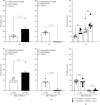The Nociceptive and Inflammatory Responses Induced by the Ehrlich Solid Tumor Are Changed in Mice Healed of Plasmodium berghei Strain ANKA Infection after Chloroquine Treatment
- PMID: 38774541
- PMCID: PMC11108701
- DOI: 10.1155/2024/3771926
The Nociceptive and Inflammatory Responses Induced by the Ehrlich Solid Tumor Are Changed in Mice Healed of Plasmodium berghei Strain ANKA Infection after Chloroquine Treatment
Abstract
Comorbidities that involve infectious and noninfectious diseases, such as malaria and cancer, have been described. Cancer and malaria induce changes in the nociceptive and inflammatory responses through similar pathophysiological mechanisms. However, it is unclear whether malaria and antimalarial treatment can change the inflammatory and nociceptive responses induced by solid cancer. Therefore, the present study experimentally evaluated the effect of infection by Plasmodium berghei strain ANKA and chloroquine treatment on the nociceptive and inflammatory responses induced by the solid Ehrlich tumor in male BALB/c mice. On the 1st experimental day, mice were infected with Plasmodium berghei and injected with tumor cells in the left hind paw. From the 7th to the 9th experimental day, mice were treated daily with chloroquine. The parasitemia was evaluated on the 7th and 10th days after infection. On the 11th experimental day, mice were evaluated on the von Frey filament test, the hot plate test, and the paw volume test. At the end of the experimental tests on the 11th day, the peripheral blood of all mice was collected for dosing of IL-1β and TNF-α. The blood parasitemia significantly increased from the 7th to the 10th day. The chloroquine treatment significantly decreased the parasitemia on the 10th day. The presence of the tumor did not significantly change the parasitemia on the 7th and 10th days in mice treated and nontreated with chloroquine. On the 11th day, the mechanical and thermal nociceptive responses significantly increased in mice with tumors. The treatment with antimalarial significantly reduced the mechanical nociceptive response induced by tumors. The hyperalgesia induced by tumors did not change with malaria. The mechanical and thermal hyperalgesia induced by the tumor was significantly reduced in mice treated and healed from malaria. On the 11th day, the volume of the paw injected by the tumor was significantly increased. The mice treated with chloroquine, infected with malaria, or healed of malaria showed reduced paw edema induced by the tumor. Mice with tumors did not show a change in IL-β and TNF-α serum levels. Mice with tumors showed a significant increase in serum levels of IL-1β but not TNF-α when treated with chloroquine, infected with malaria, or healed of malaria. In conclusion, the results show that malaria infection and chloroquine treatment can influence, in synergic form, the nociceptive and inflammatory responses induced by the solid tumor. Moreover, the mechanical antinociception, the thermal hyperalgesia, and the antiedema effect observed in mice treated with chloroquine and healed from malaria can be related to the increase in the serum level of IL-1β.
Copyright © 2024 Maria de Fatima Rodrigues Aguiar et al.
Conflict of interest statement
All authors disclose some financial and personal relationships with other people or organizations that could inappropriately influence in this work. The authors declare no conflict of interest.
Figures








Similar articles
-
Annona muricata Linn and Khaya grandifoliola C.DC. Reduce Oxidative Stress In Vitro and Ameliorate Plasmodium berghei-Induced Parasitemia and Cytokines in BALB/c Mice.J Evid Based Integr Med. 2021 Jan-Dec;26:2515690X211036669. doi: 10.1177/2515690X211036669. J Evid Based Integr Med. 2021. PMID: 34350806 Free PMC article.
-
Contribution of spinal cord glial cells to L. amazonensis experimental infection-induced pain in BALB/c mice.J Neuroinflammation. 2019 May 28;16(1):113. doi: 10.1186/s12974-019-1496-2. J Neuroinflammation. 2019. PMID: 31138231 Free PMC article.
-
[Immune characteristics of Plasmodium reinfections in mice following chloroquine cure of primary Plasmodium infections].Zhongguo Xue Xi Chong Bing Fang Zhi Za Zhi. 2020 Nov 23;32(6):569-576. doi: 10.16250/j.32.1374.2020164. Zhongguo Xue Xi Chong Bing Fang Zhi Za Zhi. 2020. PMID: 33325190 Chinese.
-
In vivo antimalarial activity of a probiotic bacterium Lactobacillus sakei isolated from traditionally fermented milk in BALB/c mice infected with Plasmodium berghei ANKA.J Ethnopharmacol. 2021 Nov 15;280:114448. doi: 10.1016/j.jep.2021.114448. Epub 2021 Jul 22. J Ethnopharmacol. 2021. PMID: 34303805
-
Effect of black seeds (Nigella sativa) on inflammatory and immunomodulatory markers in Plasmodium berghei-infected mice.J Food Biochem. 2022 Nov;46(11):e14300. doi: 10.1111/jfbc.14300. Epub 2022 Jul 14. J Food Biochem. 2022. PMID: 35833536
References
-
- Bray F., Ferlay J., Soerjomataram I., Siegel R. L., Torre L. A., Jemal A. Global cancer statistics 2018: GLOBOCAN estimates of incidence and mortality worldwide for 36 cancers in 185 countries. CA: a Cancer Journal for Clinicians . 2018;68(6):394–424. doi: 10.3322/caac.21492. Erratum in: CA Cancer J Clin. 2020 Jul; 70(4): 313. - DOI - PubMed
-
- WHO. World malaria report 2019 . Geneva: World Health Organization; 2019.
LinkOut - more resources
Full Text Sources
